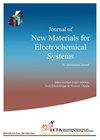Formation Mechanisms of Co-existence of α-Fe and Iron Oxides Nanoparticles Decorated on Carbon Nanofibers by a Simple Liquid Phase Adsorption-Thermal Oxidation
IF 0.6
4区 材料科学
Q4 ELECTROCHEMISTRY
Journal of New Materials For Electrochemical Systems
Pub Date : 2022-08-31
DOI:10.14447/jnmes.v25i3.a07
引用次数: 0
Abstract
We propose formation mechanisms of co-existence of α-Fe and iron oxides nanoparticles decorated on CNFs. The α-Fe nanoparticles are produced via oxidation-reduction mechanisms, which occur in liquid phase adsorption (LPA) assisted by ultrasonic energy, while α-Fe2O3 nanoparticles are thermally formed through mechanisms of Lewis acidbase. In addition, Fe3O4 is thermally formed by reducing Fe2O3 by CNFs. Liquid phase adsorption assisted by ultrasonic energy under ambient temperature using Fe(NO3)3•9H2O as a precursor of iron oxides and α-Fe has been applied. Then, as prepared, Fe(III)@CNFs were thermally calcined at 573 K under air atmosphere in various holding times ranging from 0.5 to 2 h. XRD data confirmed that α- Fe2O3 and Fe3O4 had been successfully grown onto CNFs. Moreover, the presence of the iron oxides and iron nanoparticles was studied by the SEMEDX technique. The iron oxide nanoparticles appeared after a heating period of 0.5h. However, at a holding time of 0.5 h, we found an exciting and unexpected phenomenon where oxygen content is zero percent while Fe is 0.23 wt %. It implies that α-Fe nanoparticles were formed earlier than α-Fe2O3 and Fe3O4 as the proposed mechanisms. Formation mechanisms of iron and its oxides such as α-Fe2O3 and Fe3O4 decorated on CNFs through liquid-phase adsorption followed by thermally treatment technique in this work is expected to give significant contribution in the field of nanocomposite materials, especially for anode materials based on iron oxides.简单液相吸附热氧化修饰碳纳米纤维上α-Fe和氧化铁纳米粒子共存的形成机理
我们提出了修饰在CNFs上的α-Fe和氧化铁纳米颗粒共存的形成机制。α-Fe纳米粒子是通过超声能量辅助液相吸附(LPA)的氧化还原机制产生的,而α-Fe2O3纳米粒子是通过路易斯酸碱机制热形成的。此外,Fe3O4是通过CNFs还原Fe2O3而热形成的。采用Fe(NO3)3•9H2O作为氧化铁和α-Fe的前驱体,在室温下超声能辅助液相吸附。然后,如所制备的,在573K的空气气氛下,在0.5至2小时的不同保温时间内对Fe(III)@CNFs进行热煅烧。XRD数据证实,α-Fe2O3和Fe3O4已成功生长在CNFs上。此外,通过SEMEDX技术研究了铁氧化物和铁纳米颗粒的存在。氧化铁纳米颗粒在加热0.5小时后出现。然而,在保温0.5小时时,我们发现了一个令人兴奋和意想不到的现象,其中氧含量为0%,而Fe为0.23wt%。这表明,作为所提出的机制,α-Fe纳米颗粒的形成早于α-Fe2O3和Fe3O4。本工作通过液相吸附和热处理技术修饰在CNFs上的铁及其氧化物(如α-Fe2O3和Fe3O4)的形成机制有望在纳米复合材料领域做出重大贡献,尤其是对基于铁氧化物的阳极材料。
本文章由计算机程序翻译,如有差异,请以英文原文为准。
求助全文
约1分钟内获得全文
求助全文
来源期刊

Journal of New Materials For Electrochemical Systems
ELECTROCHEMISTRY-MATERIALS SCIENCE, MULTIDISCIPLINARY
CiteScore
1.90
自引率
0.00%
发文量
33
审稿时长
>12 weeks
期刊介绍:
This international Journal is intended for the publication of original work, both analytical and experimental, and of reviews and commercial aspects related to the field of New Materials for Electrochemical Systems. The emphasis will be on research both of a fundamental and an applied nature in various aspects of the development of new materials in electrochemical systems.
 求助内容:
求助内容: 应助结果提醒方式:
应助结果提醒方式:


